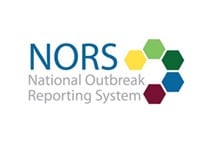At a glance
Surveillance is the term for tracking illness and injury. Waterborne disease surveillance provides information that can help prevent future disease and outbreaks while providing important information on how germs, chemicals, or toxins spread, and which types of water are linked to people getting sick.

Importance of outbreak investigations
Although we enjoy safe drinking and recreational water in the United States, waterborne diseases still pose a threat to our health and productivity. Water contaminated with germs, chemicals, or toxins can lead to waterborne illness if you drink it, breathe it in, or it touches your skin, eyes, ears, or other mucous membranes. By collecting data on the types of water, water systems, settings, and agents (what spreads the disease) that are linked to waterborne illness, we improve our understanding of waterborne illnesses and can better guide prevention efforts.
Outbreak investigations help us learn more about the causes of outbreaks. Officials can learn what germs are causing waterborne illness, what types of water are involved, and what groups of people become ill. This knowledge can be used to control an outbreak and prevent additional illnesses. Outbreak surveillance enables public health agencies to learn lessons from these investigations to develop recommendations on how to prevent similar outbreaks from happening in the future.
Many of the germs that are spread by water can also be spread in other ways, including by eating contaminated food or by contact with an ill person or animal. People come in contact with water often each day, making it even harder to know which exposure might have made a person sick. Finally, it can take several days or even weeks to become ill after being exposed to a germ, making it difficult to pinpoint the place and time of exposure. Without an outbreak investigation, it can be difficult or impossible to link illnesses to water.
When a group of people become ill at the same time, an investigation that collects information on timing and location of exposures and illnesses (known as an epidemiologic investigation) can help determine where and when the outbreak started and what caused it. An outbreak investigation can sometimes identify a direct link between the illnesses and contaminated water and might identify the type of water, systems, or settings involved. This information is difficult to gather outside of an outbreak (such as with individual infections).
Detecting/Investigating waterborne diseases and outbreaks
Waterborne disease outbreak definition
For an event to be defined as a waterborne disease outbreak
- Two or more people must be linked epidemiologically by time, location of exposure to water, and type of illness, and
- This epidemiologic evidence must implicate water as the probable source of illness.
- Environmental evidence implicating water as the source of infection (for example, water samples testing positive for germs) can strengthen evidence in a public health investigation, but the investigation must find an epidemiologic link between the illnesses and water for an event to be considered a waterborne disease outbreak.
Tracking disease
Public health officials have been tracking waterborne disease in the United States for more than 100 years. CDC has been overseeing national waterborne disease and outbreak tracking since 1971.
Surveillance data help guide efforts to reduce and prevent future outbreaks. Waterborne disease surveillance data have supported national efforts to develop drinking water regulations and have provided guidance for recreational water activities, such as CDC's Healthy Swimming program.
The national Waterborne Disease and Outbreak Surveillance System (WBDOSS) collects data on waterborne disease and outbreaks associated with recreational water, drinking water, and environmental and undetermined exposures to water. The system collects data on the number of outbreak-associated illnesses, hospitalizations, and deaths; agents; implicated types of water; water systems; and water settings. WBDOSS also collects information on single cases of waterborne illness caused by certain types of chemicals or germs.
Investigating and reporting
Investigating outbreaks
Public health officials investigate outbreaks to control them, to prevent additional illnesses, and to learn how to prevent similar outbreaks from happening. Anyone who suspects an outbreak is occurring should contact their local or state health department.
The 8 steps in an outbreak investigation are:
- DETECT a possible outbreak
- DEFINE and FIND cases
- GENERATE hypotheses
- TEST hypotheses using epidemiology, clinical data, and environmental investigation
- IDENTIFY source of outbreak
- CONTROL outbreak through remediation and outreach
- DECIDE outbreak is over
- PREVENT future outbreaks through summarizing, interpreting, and reporting findings
Several steps may happen at the same time in an outbreak investigation. Once a waterborne disease outbreak investigation ends, public health departments report outbreaks to WBDOSS.
Reporting outbreaks
Waterborne disease outbreaks became nationally notifiable in the United States in 2009. Public health agencies in all 50 states, the District of Columbia, U.S. territories, and Freely Associated States have primary responsibility for identifying and investigating waterborne outbreaks and reporting outbreaks voluntarily to CDC. From 1971 to 2008, outbreaks were reported using a paper form. Since 2009, outbreaks have been reported electronically through CDC's National Outbreak Reporting System (NORS).
See also Agricultural Water Outbreak Investigation Tools.
National Outbreak Reporting System (NORS)
The National Outbreak Reporting System (NORS) is a web-based platform used by local, state, and territorial health departments in the United States to report all waterborne, foodborne, and enteric (intestinal) disease outbreaks to CDC.

Use the BEAM Dashboard to explore national surveillance data from outbreaks and learn more about what causes these outbreaks, how often they occur, and where they occur.
